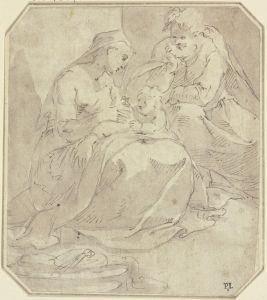
The Saints of the Crotta Family
A hand-painted replica of Giovanni Domenico Tiepolo’s masterpiece The Saints of the Crotta Family, meticulously crafted by professional artists to capture the true essence of the original. Each piece is created with museum-quality canvas and rare mineral pigments, carefully painted by experienced artists with delicate brushstrokes and rich, layered colors to perfectly recreate the texture of the original artwork. Unlike machine-printed reproductions, this hand-painted version brings the painting to life, infused with the artist’s emotions and skill in every stroke. Whether for personal collection or home decoration, it instantly elevates the artistic atmosphere of any space.
Giovanni Domenico Tiepolo, an Italian painter and printmaker, was an influential figure in the 18th century, known for his dynamic compositions and vibrant use of color. He was the son of the renowned artist Giovanni Battista Tiepolo and carried forward his father's legacy while developing his own distinctive style. One of his notable works is "The Saints of the Crotta Family," which exemplifies his skill in religious and historical themes.
"The Saints of the Crotta Family" is a painting that reflects the religious devotion and artistic patronage of the Crotta family, a prominent family in Venice during the 18th century. The painting is a testament to the family's piety and their desire to be associated with the divine through art. Giovanni Domenico Tiepolo was commissioned to create this work, which was intended to serve both as a devotional piece and a display of the family's status and wealth.
In this painting, Tiepolo showcases his mastery of composition and his ability to convey a narrative through art. The work features a group of saints, each depicted with their traditional iconography, which allows viewers to identify them and understand their significance. The saints are arranged in a harmonious composition, with a sense of movement and interaction that is characteristic of Tiepolo's style. The use of light and shadow, along with the vibrant colors, adds to the dramatic effect of the painting, drawing the viewer's attention to the central figures.
Giovanni Domenico Tiepolo's technique in this painting reflects the influence of his father, yet it also demonstrates his personal artistic evolution. He employs a lighter palette and a more fluid brushstroke, which gives the painting a sense of airiness and grace. This approach is indicative of the Rococo style, which was prevalent during this period and is characterized by its ornate and decorative qualities.
The painting not only serves as a religious icon but also as a historical document that provides insight into the cultural and social dynamics of 18th-century Venice. The Crotta family's commissioning of such a work highlights the role of art as a means of social expression and the importance of religious imagery in asserting family identity and prestige.
While specific details about the individual saints depicted in the painting or the exact location of the work today may not be extensively documented, "The Saints of the Crotta Family" remains an important example of Giovanni Domenico Tiepolo's contribution to religious art. His ability to blend narrative, devotion, and artistic skill is evident in this piece, making it a valuable part of his oeuvre and a reflection of the artistic trends of his time.
Overall, "The Saints of the Crotta Family" is a significant work that illustrates the intersection of art, religion, and society in 18th-century Venice. Giovanni Domenico Tiepolo's painting continues to be appreciated for its artistic merit and its role in the broader context of Venetian art history.
















